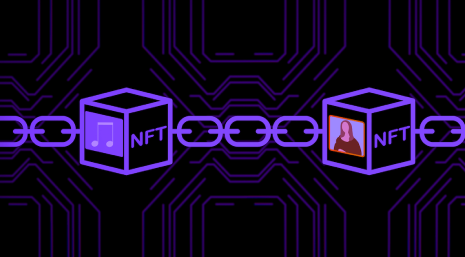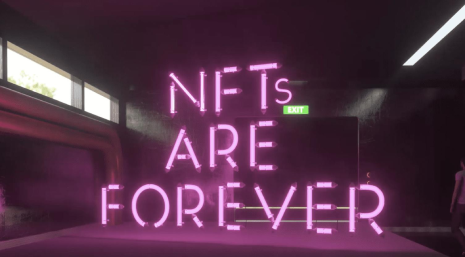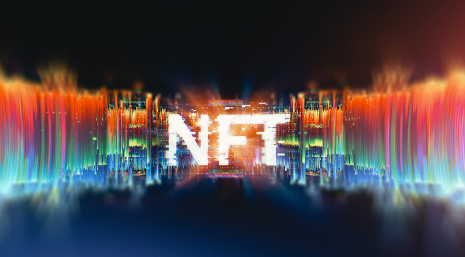share
NFT Tokens and Music
There was an NFT – non-fungible tokens sales boom this year. Digital artists and musicians have started using NFT auctions to sell NFT tied to their creations.
The absolute majority of lots at such auctions represent digital art objects (jpg paintings, gif files, videos and even burnt original works). Still, musicians are actively using hype around the new technology, successfully selling their NFTs and receiving hundreds, thousands and even millions of dollars for it.
So, DJ and producer 3Lau, Mike Shinoda from Linkin Park, singer Grimes and many others have already earned on the sale of their creations tied to NFTs. Canadian artist The Weeknd recently announced his intentions to release the NFT of his new song. Given the artist’s popularity, there is every reason to believe that he will gain a significant amount of digital assets from this transaction.

Which Musicians Should Do NFT?
The current situation in the NFT markets already resembles mass insanity — marketplaces are crowded with both novice crypto investors and digital artists trying to sell their NFTs. And if there are already special trading platforms for serious investors and collectors of digital art, then novice musicians should weigh the pros and cons before entering the game.
Creating an NFT version of your product can become a monetization tool if you are:
- An iconic musician or artist whose releases or artifacts are always of interest to collectors on every NFT marketplace
- An artist with a group of fans. They are aware of the cryptocurrency market, keep and manage cryptocurrencies. In this sense, popular musicians, for example, among developers from San Francisco who know what NFT music is, are in a more advantageous position.
- A musician that mixes music and digital art. The NFT craze began with the digital art market — primarily visual. The showcases of curated NFT marketplaces now look more like 3D galleries than streaming service charts. However, if a musician pays great attention to the visual packaging of his work, his works may be in demand at NFT auctions.
- Extremely lucky adventurer. You probably remember that at the time of the appearance of bitcoin, most financial experts considered this idea of cryptocurrencies too utopian. In a certain sense, the concept has remained utopian today, but now one bitcoin costs more than 4 million rubles. And those “adventurers” who mined or bought bitcoins 10 years ago hardly regret this investment. With music NFT, the situation is likely to be similar.
What Can I Sell as an NFT Token?

Almost any digital artifact you have created can become an object of digital art — and it can be tied to a non-fungible token and put up for auction. But also, in addition to the token, physical objects and even promises and obligations can be attached.
Moreover— you can release not one music NFT but several by creating several original and authorized copies of one object. Experts of the NFT art market have already said that the greatest interest among buyers is not individual NFTs but a series of digital art objects. Recently, the Grimes singer sold a series of works created with her brother, digital artist Mac Boucher. Some of the digital objects were accompanied by original music.
The obvious hype around NFT auctions gives scope for imagination on the topic of what can become a lot from favorite artists:
A Music Track or Album
The absolute record holder here is the American DJ and EDM producer artist 3Lau, who earned more than $ 11 million on the sale of NFT tokens tied to his release “Ultraviolet”. The release was dated 2018 and was available on all streaming platforms. Buyers of the most premium tokens received a limited edition vinyl, unreleased tracks and special mixes, and the most expensive and unique lot gave the buyer the right to create a joint track with 3Lau.
3Lau became a pioneer in another application of NFTs — he created his own private exchange, where the original buyers of NFTs can resell tokens. According to the offer, 3Lau will receive a percentage from each resale transaction of its tokens.
Album design. Files in formats .jpg and .gif or a short static video with the release cover can also be linked to NFTs. Linkin Park co-founder Mike Shinoda placed such lots at the Zora NFT auction, earning $6,600 on 10 copies of animated covers of his latest single “Happy Endings”. By the way, this was the first time a major label signatory entered the NFT market.
NFT Music Royalty

So far, the most interesting and, at the same time, mysterious area of use of NFT tokens in the music industry. At the end of February, Canadian electronic musician Jacques Green sold NFT for 13 Ethers. Not only a six-second video snippet of his track “Precise” is tied, but also a share of the royalties that will be accrued for this track. It is assumed that the creator of the composition will independently contact the buyer of NFT and, in a separate way, fix the obligations to pay royalties from this track, according to the laws of Canada. The description of the lot does not specify the percentage of deductions that the buyer of the NFT will receive, and there are no references to any contracts attached. At the moment, the deal at the NFT auction brought Jacques 23 thousand dollars in digital assets.
Blockchain technology really has enormous potential for streamlining the copyright and related rights market. Storing metadata of music files in the blockchain will make the mechanics of paying royalties to artists as transparent as possible and will also solve the problem of finding content copyright holders.
Unique Physical Objects and Even Ideas
Technically, physical objects can also be linked to a non-fungible token – even non-existent ones. For the first time, such a maneuver was made by the art provocateur Banksy, who turned his already destroyed canvas into an NFT.
You can release an NFT linked to a unique test press of the vinyl edition of your album, to specially published demos, and so on. If you fantasize a little, then technically, it will be possible to put up an artist’s promise to never release a release tied to a token at an NFT auction – and thus make money on haters.
All Kinds of Virtual Merchandise

For example, the right to listen to a new song first, an invitation to a virtual concert, exclusive access to an AR mask on Instagram, a personal video message, or virtual badges. The virtual merchandising market is just beginning to develop — before the NFT boom, one of the main marketplaces for musicians was the Fanaply service. Study their website to understand what lots and in what quantity musicians sell in the USA, and fantasize about what other virtual goods can be sold to fans.
How to Make a Release in NFT Format?

To enter the crypto market, you need to create an ethereum wallet in which you will put your reward from the sale of NFTs. You can use MetaMask, CoinBase or Rainbow services as a wallet. Simple and free registration of any wallet will take less than a minute.
- Buy yourself some ETH. In order for you to enter the auction, you must have about 0.05 Ethers (about $ 92) in your account. These funds will be spent on the so-called gas fee – the energy that is needed to initialize your NFTs. You can buy ETHs on any of the many sites for rubles or foreign currency, as well as using a QIWI wallet and the “Yandex service.Money” — or convert another cryptocurrency into Ethers, if you have one.
- Link your audio file to the IPFS interplanetary file system. Wikipedia explains IPFS as a “content-addressable, peer-to-peer hypermedia communication protocol”. Explaining what is going on with your file would take several pages of text, and information about it is easy to find on the Internet (and difficult to understand). Let’s just say that you can do it absolutely for free using the Pinata website, using this visual instruction.
- Select the marketplace where you will create and place your NFT.OpenSea is considered to be the most popular NFT market. However, for those who are just embarking on their first adventure through the murky waters of non-fungible tokens, the Rarible market is recommended. It is as simple as possible, and thanks to the partner program, the NFTs created on it are freely traded on OpenSea.
Online NFT marketplaces appear almost every day, but at the moment, the most popular music industry NFT markets are:

Rarible is the most popular site for aspiring digital artists with the simplest moderation. Releasing your NFT on Rarible is as easy as uploading a video to YouTube.

Nifty Gateway is the most elite and representative platform. In many ways, it is to her that we owe the hype around NFTs today, and it was at Nifty Gateway that the Grimes singer sold her NFT collection. Unlike other marketplaces, Nifty Gateway allows you to link not only an Ethereum wallet to your account but also a regular bank account — however, this is now relevant only for customers of American banks.

Zora is a relatively new marketplace, where musicians such as Toro y Moi and Mura Masa exhibited their lots.

SuperRare is perhaps the most snobbish platform. SuperRare does not sell meme-related NFTs but rather is a real digital art gallery. All lots are carefully selected by NFT-art critics.

OpenSea is the most popular platform for selling NFT tokens. Now, due to the increased attention to the service, the timing of the moderation of the lot may take several days.

MakersPlace is another elite NFT gallery. To sell your creativity here, you first need to get an invitation to the community via the discord messenger.
Exhibit one lot or a whole collection. One digital object (for example, the cover of your release) can be sold either as one unique NFT or as ten or even a thousand NFTs. You decide how your product will be released and how your lots will differ, what the price will be, set any auction end date — you set all the variables yourself.
Inform your fanbase about the creation of NFT or try to attract the attention of digital art collectors.
Advantages of NFT Music Marketplaces:
- Monetization of digital art. 3D art, video art, CGI graphics and other types of digital art familiar to us are extremely difficult to sell. A digital artist receives money only from a specific customer or from the sale of physical copies of his works. But now, virtual assets open up previously unexplored financial prospects for the monetization of digital creativity.
- The COVID-19 pandemic has taught us to consume content in general in a completely new way — and, most likely, this skill will only develop even after the end of the epidemic. We are already used to online concerts — but what if an entire exhibition of digital art can become a private online experience?
- Turning music into digital art. Musicians relatively quickly got used to the rules of the streaming economy, which says that their earnings are directly related to the number of times their tracks are listened to by users of different services. The sale of unique copies of releases in the form of NFT opens up opportunities for earning artists who have not yet fit into the streaming economy and who have a small but motivated audience to support the author.
The talk that most artists earn unfairly on streaming services does not subside. And the “NFT revolution” happened exactly when the concept of deductions began to be discussed more and more often, in which the money of the user of the streaming service is received only by those musicians whom the user listened to this month. The Soundcloud service will start using this method of calculating royalties from April 1. It is assumed that the distribution of royalties becomes the responsibility of the final listener. And it may be more convenient for the artist’s fans to support the artist with the purchase of NFT than to listen to only his music every day.
The development of blockchain streaming. Independent startups building streaming platforms based on blockchain technology have remained in the IT business underground for too long, and the hype around NFTs raises the stock prices of their products. Rocki, Audius, Emanate and others – the names of these streaming services are still little known to musicians, labels, and listeners, but the noise around the use of blockchain in the music industry should benefit these projects.
Popularization of charity. Popular artists, successfully selling NFTs of their creations, send the funds received to charitable foundations. This is certainly a wonderful trend, the development of which can only be welcomed. Even if all the prophecies about the blockchain are not destined to come true, targeted assistance to people who find themselves in a difficult life situation pays off any information noise a hundredfold.
Crypto investors who are now buying up NFTs may eventually become serious lobbyists, and if NFT moves from the art industry to the music industry, then after some time, major labels will open their NFT supermarkets.
Definitely, for musicians (especially songwriters), the sale of shares of rights to their tracks directly to fans will be of the greatest interest, but there is still very little reliable information about the issue of such tokens and mechanisms for dividing royalties through NFTs.






